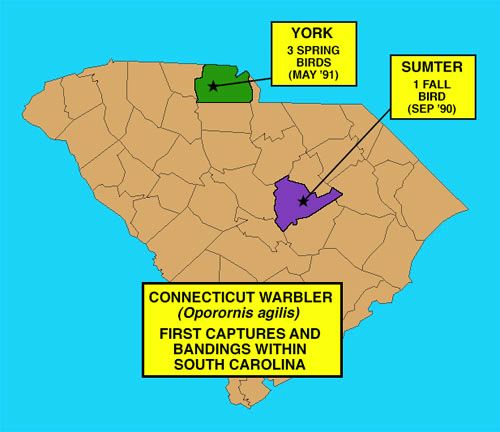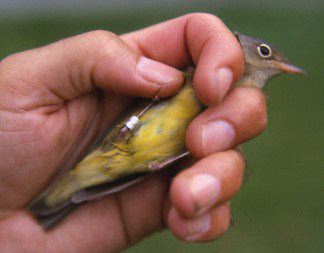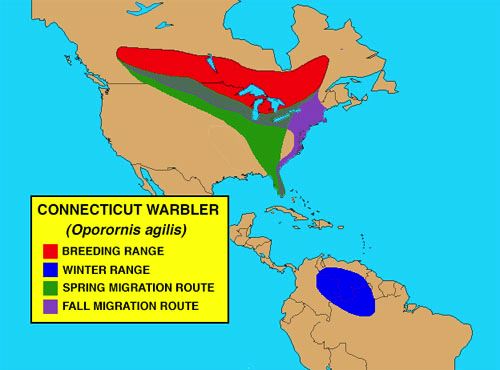|
|
|||
|
|
|||
Hilton Jr., B. 1992. First bandings of Connecticut Warblers (Oporornis agilis) in South Carolina. Chat 56(2):32-34.
(Note: The draft below was submitted to The Chat, journal of the Carolina Bird Club; the article that actually appeared in print may have been edited. The maps were produced exclusively for the Hilton Pond Center Web site.)
Although no Connecticut Warblers, Oporornis agilis, had been captured, marked, and released in South Carolina prior to 1990, four were banded during migration in September 1990 and May 1991.
The first Connecticut Warbler banded in the state was an unsexed immature bird captured about 19km east of Sumter (Lat. 33°50’N, Long. 80°10’W) on 17 September 1990 by Evelyn Dabbs and subpermittee Lex Glover (Glover, pers. comm.). In May 1991 I captured three additional Connecticut Warblers at my banding station at Hilton Pond near York, South Carolina (Lat. 34°50’N, Long. 81°10’W). According to the federal Bird Banding Laboratory in Laurel, Maryland, these four birds (see map below) are indeed the first Connecticut Warblers banded and released in the state (D. Bystrak, pers. comm.).

All text, maps & photos © Hilton Pond Center
Connecticut Warblers are very rare migrants in South Carolina. Post and Gauthreaux (1988) list only 12 acceptable records for this species in the state, four of which are study skins at The Charleston Museum or Clemson University. A fifth specimen, an immature (sex unknown) taken by Will Post on 19 September 1990 at James Island, was three days earlier than any published fall record for the species in South Carolina (Post, pers. comm.), but Dabbs’ Sumter bird preceded it by two days.
I sexed all three spring migrants at York as females because they lacked the dark gray bib, throat, and hood that are characteristic of breeding males; all had pale hoods, throats, and bibs similar to those depicted in standard field guides for female Connecticut Warblers. The first bird (U.S. Fish & Wildlife Service band #2091-21411), was netted between 0900 h and 1000 h on 13 May; its 70mm wing chord and 48mm tail made it the largest of the three captures. The second (#2091-21414) was netted between 0845 h and 0945 h on 14 May and had a 66mm wing chord and 48mm tail. The third bird (#2091-21444) was netted between 0730 h and 0830 h on 24 May—later by four days than any spring migrant Connecticut Warbler on record for the state (Post and Gauthreaux 1988); this bird measured 64.5mm (wing chord) and 48mm (tail). Based on its acute, worn rectrices, and an overall dull coloration, the third warbler was apparently a Second-Year (SY) bird hatched in 1990; this individual also had a slightly darker edging along the bottom of the bib, but I judged it too pale to be an immature male. I was unable to precisely age the other two birds either by plumage or skull pneumatization and classified them as After Hatch-Year (AHY).

The only eastern species with which the Connecticut Warbler is likely to be confused in spring is the Mourning Warbler, Oporornis philadelphia, in which color patterns are similar but the eye ring is absent or incomplete; all three birds at York had complete white eye rings (see photo above). In addition, their wing chord measurements fell within the typical range of 63mm-75mm for Connecticut Warblers (Pyle et al. 1987). The third bird’s wing chord of 64.5mm was within the the 53mm-65mm range for the Mourning Warbler, but the combination of other characteristics (especially the eye ring) ruled out that species. Dabbs’ bird (#980-86914) at Sumter also had a noticeable eye ring and a wing chord of 67mm.
|
|
BAND #
|
DATE
|
AGE
|
SEX
|
WING CHORD***
|
TAIL
|
EYE RING?
|
|
SUMTER
|
0980-86914
|
17 Sep 1990*
|
HY
|
U
|
67.0
|
—
|
Y
|
|
YORK
|
2091-21411
|
13 May 1991
|
AHY
|
F
|
70.0
|
48.0
|
Y
|
|
YORK
|
2091-21414
|
14 May 1991
|
AHY
|
F
|
66.0
|
48.0
|
Y
|
|
YORK
|
2091-21444
|
24 May 1991**
|
SY
|
F
|
64.5
|
48.0
|
Y
|
| * Earliest State Record ** Latest State Record
*** Wing chord range for Connecticut Warbler is 63-75mm; for Mourning Warbler 53-65mm |
|||||||
The birds at York were captured in standard mist nets (4-shelf, 12m long, 2m high) with 30mm or 36mm mesh diagonals. Each bird was snared in a different net but always in a shelf approximately 1.5m above the substrate. The nets were within 1m, 18m, and 25m of a 1.1 ha pond bordered primarily by Hazel Alder, Alnus serrulata, that was, in turn, surrounded by old fields from eight to 12 years into succession. The net lane closest to the pond was in an alder thicket, while the other two were in mixed vegetation dominated by Sweetgums (Liquidambar styraciflua), Eastern Red Cedars (Juniperus virginiana), and Winged Elms (Ulmus alata) approximately 4-5m tall. The Sumter bird was captured by a net in similar habitat: Shrubby growth along a low wet area on the edge of the Black River swamp.

Connecticut Warblers have circuitous migration routes (see map above). They typically leave South American wintering grounds in spring, fly north to Florida, then cut diagonally westward to the Mississippi Valley and northward to breed in the Canadian muskeg and northernmost Great Lakes states. In autumn they leave the breeding grounds, fly east to New England, south along the Atlantic Coast to Florida and the West Indies, and back to Venezuela, Colombia, and Brazil (Harrison 1984). These routes may explain why five published South Carolina spring records were from the Piedmont, while five fall records were from the coastal plain (Post and Gauthreaux 1988). The first South Carolina specimen of a Connecticut Warbler was taken in Chester in 1889 (Sprunt and Chamberlain 1970), but the species was not known from the coast until one was seen on 22 September 1967 at Garden City (Smith 1968). In 1991, an exceptionally stormy spring in the south central region of the U.S. may have caused more Connecticut Warblers to migrate northward along an easterly route through the South Carolina Piedmont, including Hilton Pond Center.
During migration the Connecticut Warbler tends to seek out thickety wet bottomlands (Sprunt and Chamberlain 1970) not easily accessible to human observers. Its olive green dorsum, gray head, throat, and bib, and pale yellow undersides—plus its habit of walking rather than hopping or flitting about in the undergrowth—combine to make the Connecticut Warbler a difficult species to find and identify even in locations where it is common.
All three Connecticut Warblers captured at York were photographed before release; color transparencies of bird #2091-21411 were submitted to The Charleston Museum and to The Chat for verification and reference.
Acknowledgments
I would like to thank Danny Bystrak of the Bird Banding Laboratory and Will Post for providing information that was used in preparing this report; Lex Glover informed me about the Connecticut Warbler banded at Sumter. Activities at the Hilton Pond banding station were funded in part by the Nongame Program of the South Carolina Department of Wildlife and Marine Resources.
Literature Cited
Harrison, H.H. 1984. Wood Warblers’ World. Simon and Schuster, New York.
Post, W. and S.A. Gauthreaux Jr. 1989. Status and Distribution of South Carolina Birds. Contribution #18, Charleston Museum, Charleston, South Carolina.
Pyle, P., S.N.G. Howell, R.P. Yunick, and D.F. DeSante. 1987. Identification Guide to North American Passerines. Slate Creek Press, Bolinas, California.
Smith, Mrs. E. 1968. Briefs for the files, J. F. Parnell, ed. Chat 32:31.
Sprunt Jr., A. and E.B. Chamberlain. 1970. South Carolina Bird Life. Reprint of 1949 ed. with Supplement by E.M. Burton. Univ. of South Carolina Press, Columbia, South Carolina.
All text, maps & photos © Hilton Pond Center
|
Make direct donations on-line through
Network for Good: |
|
|
LIKE TO SHOP ON-LINE?
Donate a portion of your purchase price from 500+ top on-line stores via iGive: |
|
|
Use your PayPal account
to make direct donations: |
|
 post questions for The Piedmont Naturalist |
Join the |
Search Engine for |
|
|